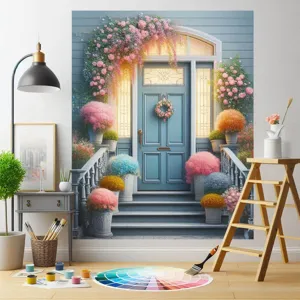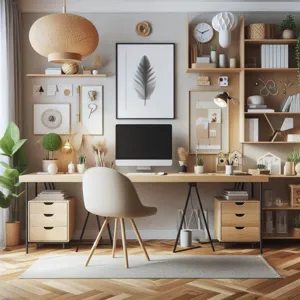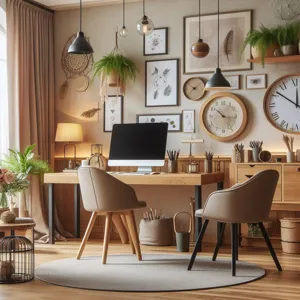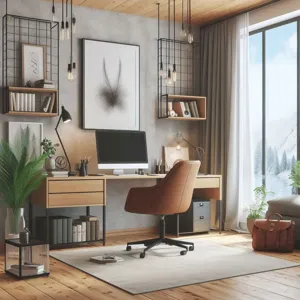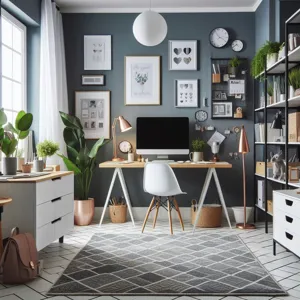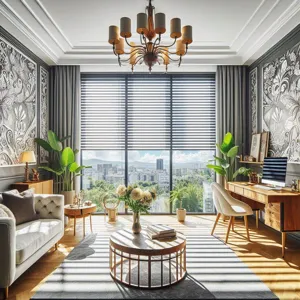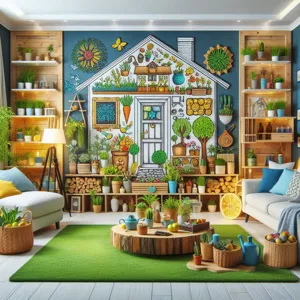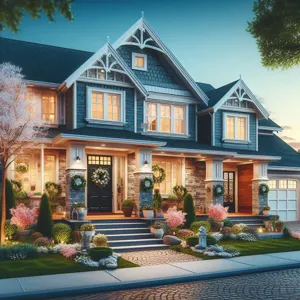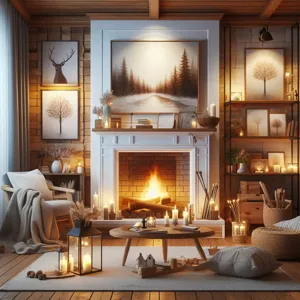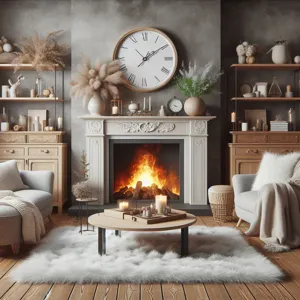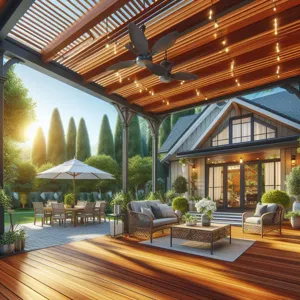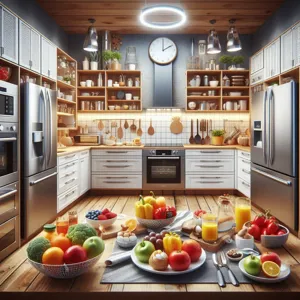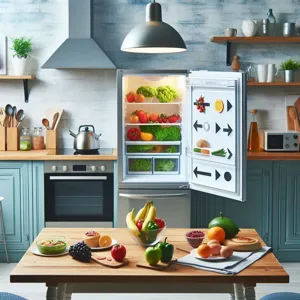In a world increasingly dominated by concrete and technology, the desire to connect with nature has never been more pronounced.
Bringing the outside in isn’t just a design trend; it’s a refreshing lifestyle choice that transforms our living spaces into serene sanctuaries filled with life and vitality. Incorporating greenery into your home not only enhances aesthetic appeal but also improves air quality and promotes a sense of well-being. Whether you have a sprawling house or a cozy apartment, there are countless creative ways to infuse your environment with the beauty of nature. From hanging planters and vertical gardens to stylish terrariums and succulents, this blog post will inspire you with innovative ideas to create your own indoor oasis. Join us as we explore the myriad of options for enriching your home with lush greenery, helping you cultivate a space that is both inviting and invigorating.
1. The Benefits of Indoor Plants

Indoor plants are not just a trendy addition to your home decor; they offer a plethora of benefits that can enhance your living space in various ways. First and foremost, they improve air quality. Plants absorb carbon dioxide and release oxygen, making the air in your home cleaner and fresher. Certain varieties, like peace lilies and spider plants, are particularly effective at filtering out toxins and pollutants, creating a healthier environment for you and your family.
Beyond their air-purifying capabilities, indoor plants also contribute to your mental well-being. Studies have shown that greenery can reduce stress, boost mood, and even increase productivity. The presence of plants is known to promote feelings of calm and relaxation, making your living space a sanctuary from the hustle and bustle of daily life. Whether it’s the soothing sight of a lush fern or the vibrant colors of blooming orchids, these natural elements can create a sense of peace.
Additionally, indoor plants can enhance the aesthetic appeal of your home. They bring a touch of nature indoors, adding texture, color, and life to your rooms. From towering fiddle leaf figs in the corner of your living room to delicate succulents on your windowsill, the variety of shapes and sizes can complement any decor style, making your space feel more inviting and vibrant.
Moreover, indoor gardening can be a rewarding hobby that fosters a deeper connection with nature. Caring for plants can be a form of mindfulness, allowing you to slow down and appreciate the little joys of life. The act of nurturing a living thing can also provide a sense of accomplishment and purpose, especially when you witness your plants thrive and flourish.
In summary, incorporating indoor plants into your home is a win-win situation. You not only beautify your space but also enrich your life with cleaner air, improved mental health, and a gratifying hobby. So, as you embark on your journey of bringing the outside in, remember that each green addition is a step toward creating a healthier and more vibrant home.
2. Choosing the Right Plants for Your Space
When it comes to transforming your home into a lush, green oasis, choosing the right plants is crucial. The ideal plant should not only complement your interior design but also thrive in the specific conditions of your space. Start by assessing the natural light available in each room. bright, sunny areas can accommodate sun-loving varieties like succulents, cacti, or vibrant flowering plants, while lower-light spaces may be best suited for hardy options like snake plants or pothos, which can flourish even in dim corners.
Next, consider the size of the plants in relation to your space. Large statement pieces, such as fiddle leaf figs or rubber trees, can serve as striking focal points in a spacious living room, while smaller plants, like air plants or mini ferns, can be used to create charming vignettes on shelves or coffee tables. Don’t forget about your lifestyle, too; if you have pets or young children, opt for non-toxic varieties to ensure safety for all family members.
Additionally, think about the maintenance level each plant requires. If you’re a busy individual with limited time for plant care, choose low-maintenance options that require minimal watering and care. Many of these resilient plants not only look beautiful but also help purify the air, contributing to a healthier living environment.
By thoughtfully selecting plants that fit your space, lifestyle, and aesthetic preferences, you can effortlessly bring the outside in, creating a vibrant sanctuary that not only enhances the beauty of your home but also nurtures your well-being.
3. Creative Plant Display Ideas
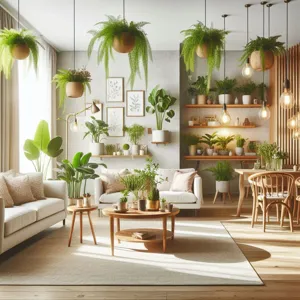
When it comes to incorporating greenery into your home, the way you display your plants can be just as important as the plants themselves. Creative plant display ideas not only elevate the aesthetic of your space but also showcase your personal style. Here are some innovative ways to showcase your leafy companions.
**1. Vertical Gardens:** Transform an empty wall into a lush green canvas by creating a vertical garden. Use a variety of wall-mounted planters or pocket planters that allow you to hang small pots filled with herbs, succulents, or trailing vines. This not only saves space but also adds a stunning focal point that invites nature indoors.
**2. Shelving Units:** Consider repurposing an old bookshelf or installing open shelves to create a mini indoor jungle. Mix and match plant sizes and types on the shelves, incorporating decorative pots that complement your home decor. This layered approach adds depth and interest, turning your plants into a dynamic display.
**3. Hanging Planters:** Utilize the vertical space in your home by incorporating hanging planters. Whether you choose macramé hangers, decorative ceramic pots, or sleek metal containers, dangling greenery can create an enchanting atmosphere. Position them near windows or in corners to draw the eye upward and create a sense of airiness.
**4. Terrariums:** For a unique touch, try creating a terrarium—a miniature garden housed within a glass container. These self-contained ecosystems can be customized with various plants, stones, and decorations to reflect your personality. They make for beautiful centerpieces on coffee tables or accent pieces on shelves.
**5. Plant Stands:** Elevate your plants with stylish plant stands that add height and dimension to your displays. Choose from a variety of materials, such as wood, metal, or ceramic, to match your decor. Stacking different heights together can create an eye-catching arrangement that draws attention to your favorite greenery.
By experimenting with these creative plant display ideas, you can bring the outside in and create a vibrant, inviting atmosphere in your home. Not only will your space feel more alive, but the thoughtful arrangement of plants will also inspire you to nurture your green thumb and enjoy the beauty of nature indoors.
4. Vertical Gardening: Maximizing Space with Greenery
Vertical gardening is a game-changing trend that allows you to transform even the smallest of spaces into lush, green havens. If you’re limited on floor space or live in an apartment with minimal access to a garden, this innovative approach enables you to maximize your environment by utilizing vertical surfaces—walls, fences, and even balconies—effectively turning them into living art.
One of the key benefits of vertical gardening is its ability to create a stunning visual impact. Imagine a wall adorned with cascading vines, vibrant flowers, or an array of herbs, each adding texture and color to your home. Living walls can serve as beautiful focal points in your living room or kitchen, bringing an element of nature inside and enhancing your décor with organic beauty.
To get started, consider using wall-mounted planters, trellises, or even repurposed items like pallets or shoe organizers. Choose plants that thrive in vertical arrangements, such as ferns, succulents, or climbing varieties like ivy and jasmine. Herbs like basil and mint not only look great but also provide a fresh supply for your culinary endeavors.
For those looking to take it a step further, installing a hydroponic system can revolutionize your vertical gardening experience. This soil-less method allows plants to grow in nutrient-rich water, giving you the ability to cultivate a wide range of greenery in smaller spaces without the mess of traditional gardening.
In addition to the aesthetic appeal, vertical gardens can also improve air quality and promote a sense of tranquility in your home. The presence of greenery has been shown to reduce stress and enhance overall well-being, making your indoor environment not just more beautiful, but healthier too.
Embrace the art of vertical gardening and watch as your home transforms into a vibrant sanctuary filled with life, all while making the most out of your available space. Whether you opt for a simple DIY project or a sophisticated indoor garden system, the possibilities are endless, and the rewards are undeniably refreshing.
5. Using Plants as Natural Dividers

Using plants as natural dividers is an innovative and visually striking way to define spaces within your home while simultaneously enhancing its aesthetic appeal. Unlike traditional room dividers or bulky furniture, greenery introduces a refreshing touch that brings the outdoors in, creating a serene and inviting atmosphere.
Imagine a spacious open-plan living area where a tall, leafy fiddle leaf fig or a cascading pothos subtly delineates the dining space from the living room. These vibrant plants not only serve a functional purpose but also add a layer of texture and color, creating a seamless transition between areas without the need for walls.
For smaller spaces, consider using a collection of smaller plants arranged on a stylish plant stand or shelf. This creates a tiered effect that can visually separate zones while still allowing light to flow through. Additionally, vertical gardens or wall-mounted planters can transform bare walls into lush green canvases, offering both privacy and style without sacrificing floor space.
In outdoor areas, large potted plants can effectively create cozy nooks on balconies or patios. Strategically placed, they can offer a sense of enclosure, making these spaces feel more intimate and inviting.
When selecting plants for this purpose, consider options that thrive in the lighting conditions of your home. Tall, architectural plants like snake plants or palms work beautifully in corners, while trailing plants like ivy or string of pearls can soften edges and create a more organic feel.
By incorporating plants as natural dividers, you not only enhance your home’s decor but also promote a healthier living environment. Foliage can improve air quality, reduce stress, and elevate your mood, making your home a true sanctuary. Embrace the beauty of nature and let your interior spaces flourish!
6. DIY Planters: Personalizing Your Green Space
Creating your own DIY planters is a delightful way to add a personal touch to your green space while showcasing your creativity. Not only do these planters provide a unique aesthetic, but they also allow you to express your style and preferences in your home décor. The process can be both rewarding and relaxing, making it an ideal weekend project for plant lovers and DIY enthusiasts alike.
Start with materials you have on hand or visit your local craft store for inspiration. Wooden crates, terracotta pots, repurposed tin cans, or even old shoes can transform into charming planters with just a bit of imagination. Consider painting or staining your containers in vibrant colors or subtle pastels to complement your interior design. Adding stencils or hand-painted designs can elevate the look, making each planter a small work of art.
For a more rustic feel, try using natural materials like woven baskets or driftwood to create an organic look. You can also experiment with vertical planters by stacking small pots or utilizing a pallet to create a living wall, maximizing your space while adding depth to your decor.
Don’t forget to incorporate drainage holes in your planters if necessary, as this will help keep your plants healthy and thriving. Once your planters are ready, choose plants that resonate with your style—succulents, herbs, or colorful flowers can all add vibrancy and life to your home.
By personalizing your planters, you not only create a unique green oasis within your living space but also cultivate a sense of pride in your home. Each time you look at your DIY creations, you’ll be reminded of your creativity and the joy that greenery brings to your environment. So gather your supplies, unleash your imagination, and let your indoor garden flourish!
7. Incorporating Plants into Your Decor Style

Incorporating plants into your decor style is not just about adding a splash of color; it’s about creating a vibrant atmosphere that breathes life into your home. Whether you lean towards a minimalist aesthetic, modern chic, rustic charm, or bohemian flair, there are countless ways to seamlessly integrate greenery into your spaces.
For a minimalist approach, consider using a single statement plant, such as a tall fiddle leaf fig or a sleek snake plant, placed strategically in a corner or beside a piece of furniture. This not only adds height and interest but also maintains a clean, uncluttered look. Alternatively, if your style is more eclectic, mix and match a variety of smaller plants—succulents, air plants, or trailing vines—displayed in an array of colorful pots on shelves, windowsills, or hanging from the ceiling. This creates a playful and inviting atmosphere.
For those who appreciate a rustic vibe, think about using reclaimed wood planters or vintage pots to house your greenery. Herbs like rosemary and thyme can thrive in a kitchen window, not only adding a fragrant touch but also serving as a functional element in your cooking. Meanwhile, a macramé plant hanger can add a trendy bohemian twist, allowing trailing plants like pothos or string of hearts to cascade beautifully.
Moreover, don’t forget the power of wall-mounted planters. These can serve as living art pieces, transforming a blank wall into a lush vertical garden. When choosing plants, consider their light requirements and growth patterns to ensure they thrive in their designated spots.
By thoughtfully incorporating plants that resonate with your decor style, you create a cohesive look that enhances the aesthetic of your home while fostering a calming and revitalizing environment. Embrace the myriad of textures and colors that plants offer, and watch as your space transforms into a sanctuary of greenery.
8. The Role of Light in Plant Placement
When it comes to incorporating greenery into your home, understanding the role of light in plant placement is crucial for both aesthetics and plant health. Different plants have varying light requirements, and recognizing these needs can make all the difference in creating a thriving indoor garden.
Natural light floods through your windows, creating a vibrant canvas that can enhance the beauty of your plants. For instance, succulents and cacti thrive in bright, direct sunlight, making a south-facing window the perfect spot for them to bask in their glory. Their striking shapes and colors can become focal points, adding a touch of the desert to your living space.
On the other hand, if you have a cozy nook that receives only filtered light, consider plants like snake plants or pothos. These resilient varieties not only tolerate lower light conditions but also bring a lush, cascading effect that softens the edges of a room. Their ability to purify the air is an added bonus, making them an excellent choice for bedrooms or home offices.
Moreover, understanding the movement of the sun throughout the day can help you strategically place your plants for optimal growth. Rotate your pots periodically to ensure even exposure, which can help prevent uneven growth and keep your greenery looking lush and full.
Additionally, consider incorporating grow lights for areas that lack sufficient natural light. These artificial lights can mimic the sun’s rays, allowing you to expand your botanical horizons without the constraints of your home’s lighting conditions.
In summary, thoughtfully considering the light requirements of your plants not only promotes their health but also enhances your home’s aesthetic. By strategically placing greenery based on light accessibility, you can create a harmonious balance that breathes life into any room, fostering an inviting atmosphere that bridges the gap between the indoors and the great outdoors.
9. Terrariums: Bringing a Mini Ecosystem Indoors
Terrariums are a captivating and enchanting way to bring the beauty of nature into your home, offering a miniature ecosystem that thrives within the confines of glass. These self-sustaining gardens, often housed in jars or geometric containers, not only add a touch of greenery to your space but also serve as a stunning focal point that sparks conversation.
Creating a terrarium is an art form that combines creativity with a basic understanding of plant care. Start with a clear glass container, which can range from simple mason jars to intricate hanging globes or even larger display cases. The beauty of terrariums lies in their versatility; you can design a lush tropical paradise, a dry desert landscape with succulents, or even a whimsical fairy garden with tiny figurines nestled among the foliage.
The layering process is essential to ensure the health of your plants. Begin with a drainage layer, such as small pebbles or activated charcoal, to prevent water from stagnating and causing root rot. Follow this with a layer of soil suitable for your chosen plants, allowing enough space for their roots to spread. When selecting plants, consider varieties that thrive in enclosed environments, such as ferns, mosses, and small air plants, which will flourish in the humidity of the terrarium.
Once assembled, the closed environment of a terrarium creates its own microclimate, making it a low-maintenance option for the busy urban dweller. The glass acts as a greenhouse, trapping moisture and heat, allowing the plants to photosynthesize and thrive with minimal intervention. Just remember to periodically check for condensation and give your terrarium some indirect sunlight to keep your mini ecosystem healthy.
Beyond their aesthetic appeal, terrariums also serve as a reminder of the wonders of nature, bringing a slice of the outdoors into your daily life. Whether placed on a coffee table, desk, or windowsill, these living artworks invite tranquility and natural beauty into your home, making them an ideal addition for anyone looking to enhance their space with a touch of green.
10. Edible Plants: Growing Herbs and Veggies at Home
Incorporating edible plants into your home not only enhances your décor but also invites the delightful benefits of fresh herbs and vegetables right to your kitchen. Imagine snipping a sprig of basil or plucking a ripe tomato just moments before adding them to your favorite dish. Growing your own herbs and veggies is a rewarding endeavor that combines aesthetics with functionality.
Start small by selecting a few easy-to-grow herbs like basil, mint, or rosemary. These fragrant plants thrive indoors with minimal care and can be cultivated on a sunny windowsill or in decorative pots that complement your kitchen’s style. Choose containers that allow for good drainage and consider varying their heights to create an appealing visual display. The vibrant greens and aromatic scents not only beautify your space but also infuse your culinary creations with fresh flavors.
For those with a bit more space, exploring vertical gardening options or dedicated indoor garden kits can yield a bounty of vegetables. Microgreens, lettuce, and peppers are great choices that do well in smaller areas and provide a sense of achievement as you watch them grow. Utilizing hydroponic systems can also simplify the process, allowing you to grow produce in water without soil, making it ideal for urban dwellers with limited outdoor access.
In addition to being visually stunning and practical, growing your own edible plants can foster a deeper connection to the food you consume. It encourages a sustainable lifestyle and reduces the need for store-bought produce, which often comes with excessive packaging. Plus, the joy of harvesting your homegrown herbs and veggies can transform cooking into a more engaging and fulfilling experience.
So, whether you’re a seasoned gardener or a curious beginner, introducing edible plants into your home is a creative way to enhance your living space, while also embracing a lifestyle that celebrates fresh, homegrown goodness. Get your hands dirty and experience the satisfaction of cultivating your own green oasis right in your kitchen!
11. Care Tips for Keeping Indoor Plants Thriving
Bringing the beauty of nature indoors can transform your living space into a vibrant and inviting sanctuary. However, to truly enjoy the benefits of indoor plants, it’s essential to know how to care for them properly. Here are some key care tips to ensure your leafy companions thrive and flourish in your home.
**1. Understand Light Requirements:** Different plants have varying light needs, from low-light tolerant varieties like snake plants to sun-loving succulents. Position your plants according to their preferences, and consider the seasonal changes in sunlight. Don’t hesitate to experiment with different spots in your home until you find the ideal location.
**2. Water Wisely:** Overwatering is one of the leading causes of indoor plant demise. It’s crucial to gauge your plant’s water needs based on its type, size, and the environment it’s in. Check the soil moisture regularly; if the top inch of soil feels dry, it’s time to water. Always use pots with drainage holes to prevent water from pooling at the bottom, which can lead to rot.
**3. Maintain Humidity:** Many indoor plants, especially tropical varieties, thrive in higher humidity levels. If your home is dry, especially during winter months, consider using a humidifier or placing a tray of water with pebbles beneath your plants. Misting their leaves occasionally can also help, although be mindful of plants that might not appreciate moisture on their foliage.
**4. Fertilize Appropriately:** Indoor plants benefit from regular feeding, especially during the growing season (spring and summer). Use a balanced liquid fertilizer every few weeks, following the manufacturer’s instructions. Be cautious not to over-fertilize, which can harm the roots and lead to unhealthy growth.
**5. Prune and Repot:** Regularly inspect your plants for dead or yellowing leaves, which should be pruned to promote new growth. As your plants grow, they may outgrow their containers. Repotting them into a slightly larger pot with fresh soil can give them the space and nutrients they need to continue thriving.
**6. Watch for Pests:** Keep an eye out for common pests like spider mites, aphids, or mealybugs. If you notice any signs of infestation, act quickly by isolating the affected plant and treating it with insecticidal soap or neem oil.
By following these essential care tips, you can create a flourishing indoor garden that not only enhances your home’s aesthetic but also contributes to your well-being. With a little attention and love, your indoor plants will thrive, bringing fresh air and a sense of tranquility to your living space.
12. Seasonal Plant Arrangements for a Fresh Look
Incorporating seasonal plant arrangements into your home is a delightful way to refresh your space and embrace the changing moods of nature throughout the year. Think of your home as a canvas, and plants as the vibrant colors that bring it to life. Each season offers unique opportunities to showcase a variety of textures, colors, and scents that can transform your environment and elevate your mood.
In spring, consider vibrant blooms like tulips or daffodils, which symbolize renewal and growth. Place them in cheerful, pastel-colored pots to enhance the fresh, uplifting spirit of the season. Transitioning into summer, you can introduce lush greens and tropical plants like monstera or fiddle leaf figs, which thrive in the warm weather and bring a bold, exotic flair to your living areas.
As autumn approaches, swap out your bright blooms for richer, earthier tones. Incorporate seasonal favorites such as chrysanthemums or ornamental kale, and don’t shy away from adding rustic elements like pinecones or branches to your arrangements. These additions can evoke the cozy essence of fall, making your home feel inviting and warm.
When winter arrives, evergreen plants and festive arrangements can keep your space feeling alive despite the chilly weather outside. Consider a beautiful arrangement of holly and pine, or perhaps a compact indoor tree adorned with ornaments that reflect your personal style. You can even create a terrarium with winter-themed decorations to bring a touch of whimsy to your decor.
By curating seasonal plant arrangements, you not only enhance your home’s aesthetic but also create a dynamic atmosphere that reflects the beauty of nature’s cycles. Keep your arrangements varied and playful, and your home will always feel fresh and inviting, no matter what time of year it is.
13. How to Create a Plant Care Routine
Creating a plant care routine is essential for ensuring that your indoor greenery thrives and flourishes. Just like any living thing, houseplants require consistent attention and care to reach their full potential. By establishing a structured routine, you not only enhance the health of your plants but also deepen your connection to nature within your home.
Start by assessing the specific needs of each plant species in your collection. Different plants have varying requirements for sunlight, water, humidity, and nutrients. Make a list and categorize your plants based on their care needs. For example, succulents and cacti thrive in bright, direct sunlight and require infrequent watering, while tropical plants like ferns and peace lilies prefer indirect light and a more humid environment.
Next, incorporate regular watering into your routine. set a specific day of the week to check on your plants; this could be a leisurely Sunday morning or a mid-week check-in. Use this time to assess the moisture level of the soil—stick your finger about an inch deep to gauge whether it’s time to water. Remember, overwatering is a common mistake, so it’s crucial to ensure the soil is dry before adding more water.
Fertilizing is another key aspect of plant care. Most houseplants benefit from a balanced fertilizer every few months, particularly during the growing season in spring and summer. Mark your calendar to remind yourself when it’s time to feed your plants, ensuring they receive the nutrients they need to thrive.
Don’t forget about pruning and cleaning! Dust can accumulate on leaves, blocking sunlight and hindering photosynthesis. Incorporate a gentle cleaning session into your routine once a month—simply wipe the leaves with a damp cloth to help them breathe easier. Additionally, pruning dead or yellowing leaves encourages new growth and keeps your plants looking their best.
Lastly, take time to simply enjoy your plants. Schedule regular moments to appreciate their beauty and monitor their growth. This connection not only fosters a sense of tranquility in your space but also motivates you to maintain your plant care routine. By dedicating time to these simple tasks, you’ll create a thriving indoor garden that brings the vibrancy of nature into your home.
14. Combining Art and Nature: Plant Art Installations
Incorporating greenery into your home decor can transcend traditional potted plants and create stunning focal points that blend art with nature. Enter the world of plant art installations—a creative approach that transforms living spaces into lush, vibrant galleries. These installations can range from intricate wall-mounted planters to striking hanging gardens that draw the eye upward, celebrating the beauty of both flora and artistic expression.
Imagine a living wall adorned with a curated selection of succulents, ferns, and flowering plants, arranged in a mosaic pattern that shifts with the seasons. This dynamic display not only serves as a breathtaking backdrop but also acts as a natural air purifier, enhancing the overall ambiance of your home. Alternatively, consider crafting a three-dimensional art piece using driftwood or reclaimed materials, entwined with climbing vines or cascading string of pearls. This fusion of materials can evoke a sense of tranquility, reminiscent of a serene forest, while also showcasing your personal style.
For those with a penchant for minimalism, a single large-scale terrarium might be the answer. These glass-enclosed ecosystems can feature a variety of plants, stones, and even decorative elements like fairy lights or miniature figurines. Position it on a coffee table or a shelf, and it becomes not just a plant, but a conversation starter—an ever-evolving piece of living art that invites curiosity and admiration.
By embracing plant art installations, you invite the essence of the outdoors into your home in a way that is both innovative and deeply personal. The marriage of art and nature can invigorate your living spaces, making them feel more vibrant and alive while reflecting your unique aesthetic. So, unleash your creativity, and let your home blossom into a breathtaking gallery where nature takes center stage.
15. Greenery in Unexpected Spaces: Bathrooms and Kitchens
When we think of adding greenery to our homes, our minds often drift toward living rooms and bedrooms, but the bathrooms and kitchens can become delightful green sanctuaries too. These spaces, typically overlooked, can benefit greatly from a splash of plant life, transforming them into fresh and inviting areas.
In the bathroom, humidity levels are usually higher due to showers and baths, creating an ideal environment for many plants. Consider hanging a trailing pothos from a shelf or a small window sill. Its cascading vines can soften the sterile lines of bathroom fixtures and create a calming atmosphere. Alternatively, small ferns thrive in these conditions, their lush foliage bringing a touch of nature to your daily routines. For those with limited light, low-maintenance options like snake plants or peace lilies can flourish with minimal care, all while purifying the air.
Kitchens, on the other hand, are perfect for integrating functional greenery. Herbs like basil, mint, and rosemary not only add a pop of color but also serve a practical purpose, offering fresh ingredients at your fingertips for culinary creations. You can place small pots on the windowsill or create a vertical herb garden on a wall-mounted shelf. Additionally, larger leafy plants, such as spider plants or rubber trees, can fill empty corners, lending life to what might otherwise be a utilitarian space.
When choosing plants for these unexpected spaces, think about the light, humidity, and your own maintenance capabilities. With a little creativity and consideration, you can turn your bathrooms and kitchens into lush, green havens that breathe life into your home. Embrace the tranquility and freshness that greenery brings, and watch as these spaces transform into your new favorite retreats.
In conclusion, infusing your home with greenery is not only a way to enhance your decor but also a means to create a serene and inviting atmosphere. As we explored in this post, there are countless creative ways to bring the outside in, from stylish indoor gardens and vertical plant walls to charming terrariums and unique plant displays. Each method offers a chance to personalize your space while reaping the numerous physical and mental health benefits that plants provide. So, whether you’re a seasoned plant parent or a beginner looking to dip your toes into the world of indoor gardening, we encourage you to experiment with these ideas and find what resonates with you. Embrace the beauty of nature within your home, and watch as your space transforms into a lush, vibrant oasis that brings joy and tranquility to your everyday life. Happy decorating!

